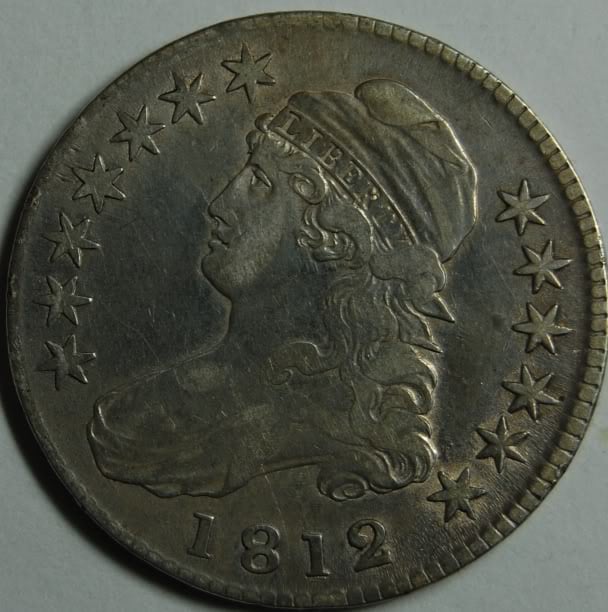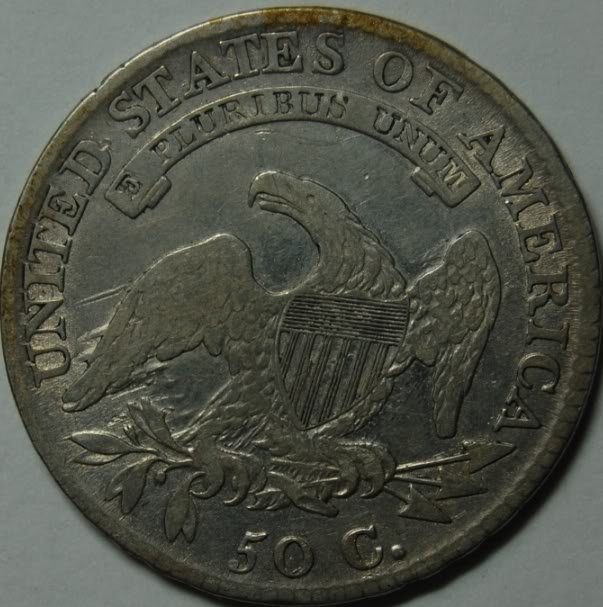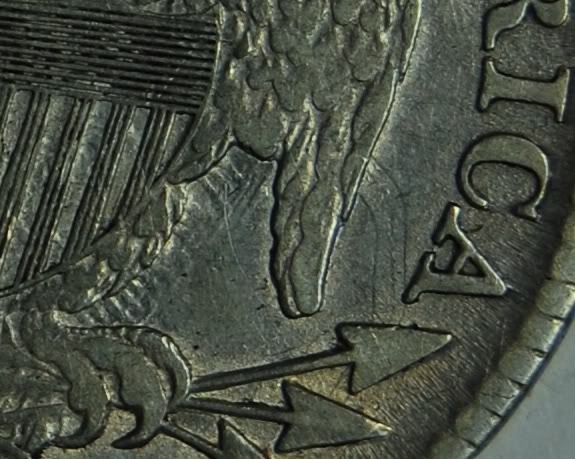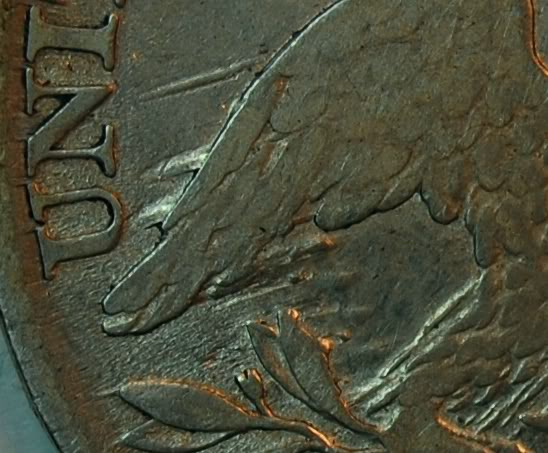Multiple clashes on bust coins (bust quarter used as example)
 scubafuel
Posts: 1,950 ✭✭✭✭✭
scubafuel
Posts: 1,950 ✭✭✭✭✭
I recently purchased a 1818 B-2 quarter with very apparent clashing on the obverse and reverse. Along with the heavy die cracking, this coin must have been one of the last produced with this obverse die.
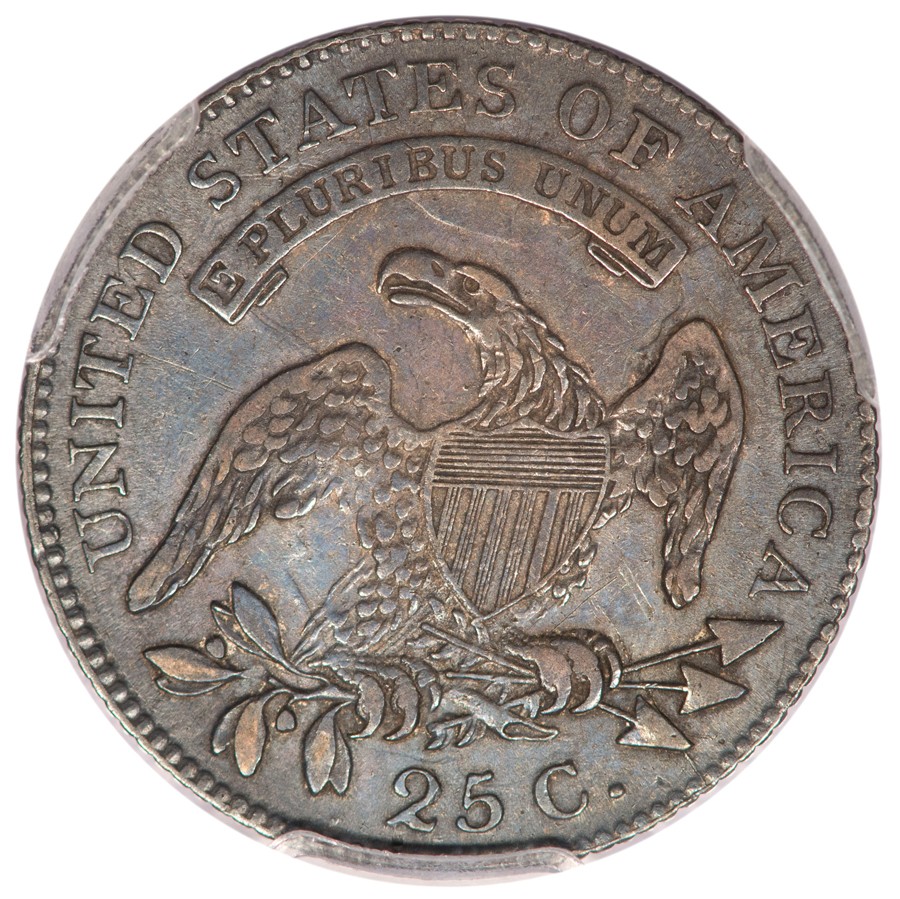
All the lettering in "Pluribus Unum" can be seen in the clashed motto, and even the eagle's left wing feathers seem to have been clashed into the obverse! Dentils are clashed in above the die crack at 1 o'clock. Not only is this clash very strong, but it is doubled (at least) showing that it happened more than once.
My understanding of the early minting process is a bit shaky, but how did those guys accidently create so many clashed dies using a screw press? Seems like there would be plenty of time to realize that a planchet was missing from the striking chamber in the days before everything was mechanized. Any thoughts?
If you have a severely clashed bust coin, please post it here. They are rare on quarters but I know there are some epic clashes on the halves and half dimes.
Also, looking at past posts, this coin may have been owned by another forum member ~10 years ago. If so, I'd love to hear the backstory.
Comments
David Perkins has this one.
If they were making a million of these a year, could not have been too much time between strikes. I envision a pretty quick process with occasional slip ups.
The press had at least three people, two at opposite ends of the crossbar swinging it back and forth in a rhythmical manner, and a third taking care of the planchet feeding mechanism. Once the third guy became aware of a missing planchet, he would have to react and yell stop! I would assume that the cycle time of the crossbar was less than the reaction time of the third guy.
In the capped bust half series, the years 1813 and 1814 were noted for lots of clashing. Here are a couple of 1814's with some cool obverse and reverse (not as well seen) clashes.
Dave
Don't know if this was the last coin obv 2 made,
but it was discarded and sold for scrap steel and
used to strike a Large Cent 1818 N-8 and is listed
as Judd-45.
To add to what the CAPT. said about using the
screw press, Steve Tompkins states in his book
Early United States Quarters 1796-1838, that when
dies were removed from the press to be repaired
or lapped , if only one die were removed & then
the press was made to operate, a clash would occur.
I doubt that young screw press operators were at
their peak efficiency after a day of striking 20,000 coins.
The REV die went on to to strike the B-3 marriage with
obv 1, 8 over 5 used for B-1.
Please try to show both obv. & rev. images if you can.
It often helps. The obv you showed is great !
R.I.P. Bear
Wow! A lot going on here. What are the chances of getting a reverse pic?
Don't understand how you could have a die clash with only one die in the press.
Pretty awesome!
Some great clashes, thanks Barndog and Dave!
Reverse pic added of the 1818 quarter. The clashing is not as apparent, but you can see the clashed date between the motto and "States".
Clashed and rusted die here:
The lighting sucked and they were going fast?
Awesome B-2 quarter and '37 HD, Barndog!
Lance.
.
Whoops ! I must be off my meds. Sorry about that.
R.I.P. Bear
Scubafuel, nice to see another Forum member acquire one of my bust quarters. I've enjoyed having this 1818 B-2 VLDS in my collection for the last ten years, especially for how well it retained it's clashing details. I agree that it must be one of the last for the variety, and it's the only one that I've ever seen where you can read the "E Pluribus Unum" lettering like this.
I always felt it was double clashed as well. I think the second clashing gave the better impression (or third, if there was a third), and the clashings may have hastened the obverse die crack, pushing towards a retained cud.
Here is my example with the single clashing (see the scroll under the date), and a lighter die crack:
Here are Phil's Trueviews of Scubafuel's VLDS coin I had done prior to trading it in a Baltimore deal:
Next is a worn example of the 1818 B-2 VLDS. It looks similar to the previous coins die state, or could be later with the area of the crack now looking sunken from the die. However, it's hard to tell due to the coins wear. These are the latest states I've seen.
Also, Great examples, Barndog, drddm, & Manorcourtman!
1TwoBits
Clashed dies are interesting.... there are a couple here that are very significant....not the minor tracing normally encountered. Cheers, RickO
@scubafuel , awesome Quarter!!!
Congratulations on adding this to your Quarter Collection. Hope to see this coin someday!
W. David Perkins Numismatics - http://www.davidperkinsrarecoins.com/ - 25+ Years ANA, ANS, NLG, NBS, LM JRCS, LSCC, EAC, TAMS, LM CWTS, CSNS, FUN
1TwoBits, thanks for the info! I'm honored to have one of your quarters in my set. Did you own this coin before the Tompkins book came out? I believe it is pictured in the book on page 78.
Interestingly, the clashes are gone again (it seems) from your VLDS quarter, but the die crack / retained cud is now sunken significantly. The mint must have cleaned the clash marks off the obverse die again and kept striking. Dies were too expensive to waste, but all that lapping must have taken its toll on some detail.
The fact that the retained cud on the obverse was sunken instead of raised also points to the likelihood that the reverse die was the hammer die, correct? Otherwise that section would have raised like the cud on 1825 B-3 below.
Looks like a year has gone by and another FUN showing is coming up fast! Anyone else have massively clashed coins to show off? Doesn't have to be Bust series.
Wish I did, this is a great thread.
When I'm pickin I'm also lookin for clashing. Peace Roy
BST: endeavor1967, synchr, kliao, Outhaul, Donttellthewife, U1Chicago, ajaan, mCarney1173, SurfinHi, MWallace, Sandman70gt, mustanggt, Pittstate03, Lazybones, Walkerguy21D, coinandcurrency242 , thebigeng, Collectorcoins, JimTyler, USMarine6, Elkevvo, Coll3ctor, Yorkshireman, CUKevin, ranshdow, CoinHunter4, bennybravo, Centsearcher, braddick, Windycity, ZoidMeister, mirabela, JJM, RichURich, Bullsitter, jmski52, LukeMarshall, coinsarefun, MichaelDixon, NickPatton, ProfLiz, Twobitcollector,Jesbroken oih82w8, DCW
All kinds of clashing going on here... obverse & reverse.
The number of men depended on the size of the press. According to a Nov 1836 letter from Patterson to Woodbury, the largest screw press required 5 men, while the next smaller one required 4. Both were being used for half dollars at the time
George Eschol Sellers noted that the cent press was operated by one man. Sine Sellers only mentioned the man swinging the fly-arm, I assume there was another feeding, as it wouldn't make sense for the man to stop every 20 seconds or so to fill the feed tube.
B.C. Wailes noted in 1829 that there were two men on the swing arm, one at each end, and likewise does not mention anyone feeding. He estimated the striking rate at 60/min. Since he specifically mentions half eagle being struck, that's liely the rate for tortoise pieces and similar size.
Frederick Star visited the mint in 1828, noted 3 men on the swing arm, and that they told him they could strike 43 half dollars a minute.
Robert W. Scott visited in 1829, likewise seeing half dollars stuck and likewise noting three men on the arm. He stated 2000 half dollar were stuck in a half hour (33/min).
Finally, Franklin Peale noted in his 1835 report that the French were striking five francs at 35/min on their screw presses.
As to operating the presses, the best view comes from Ackermann's Microcosm of London, which shows men alternately pushing and pulling on wooden poles attached to the ends of the fly arm.
Die clashing was generally a result of a miss-feed. Most likely, the planchets jammed in the fed tube, so the fingers failed to deliver it. Feed fingers are shown in Cooper and a couple period encyclopedias.
Multiple clash strikes on this one--note the multiple LIBERTYs on the reverse (twice within shield and another under wing)--with a die rotation between the clashes thrown in for good measure.
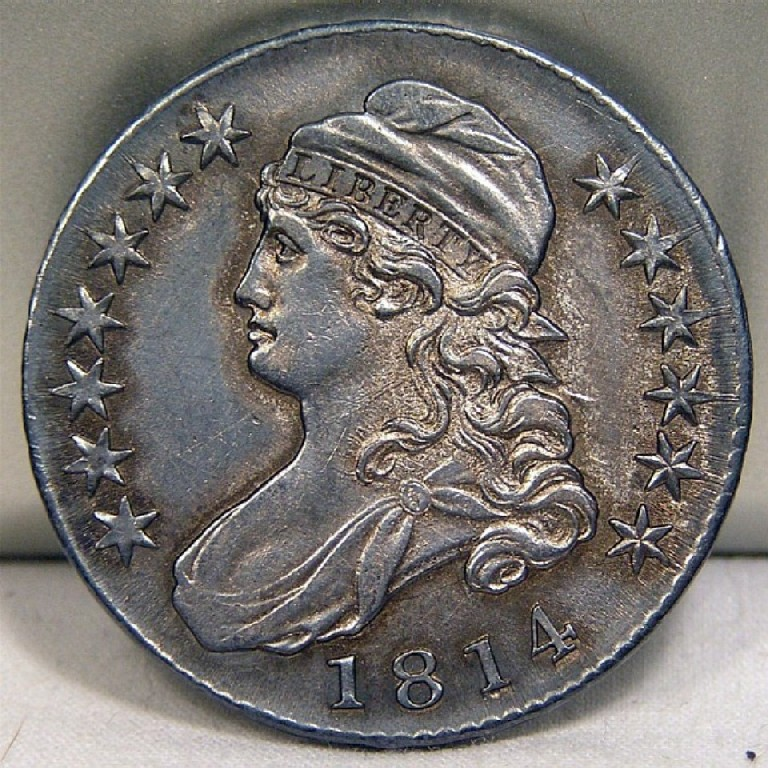
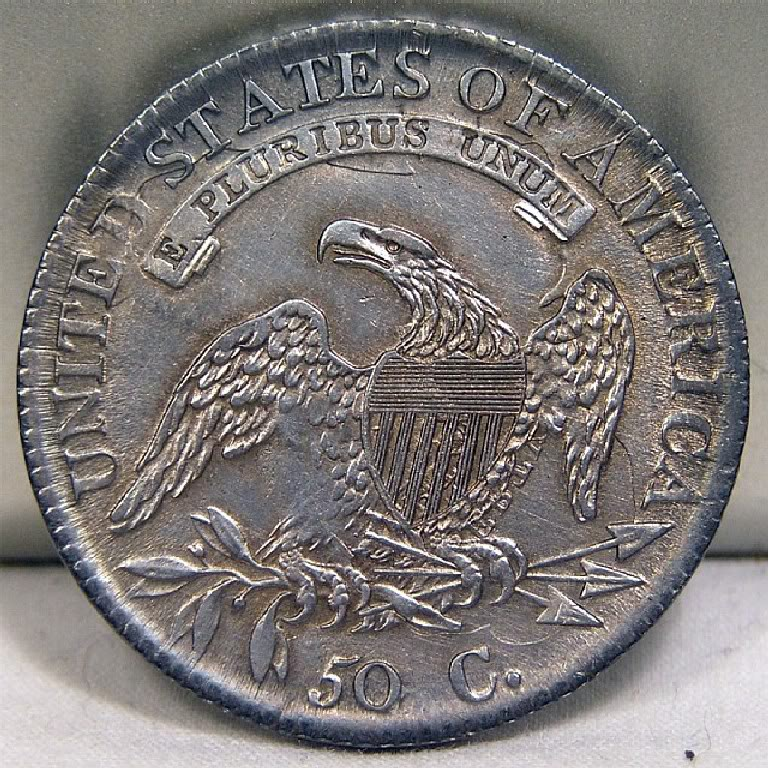
Awesome 1811 $5! I had not seen clashing that extensive on a gold piece before. And the 1814 half is just nuts. The spacing between clashed "Liberty"s suggests a loose die or loose machinery?
The 1812 O-109a shows strong, in this case triple clashing as well as a nice strike through (a screw?)
